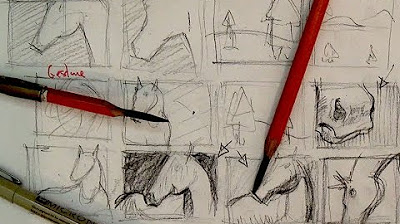How to Draw A Thumbnail Drawing
Summary
TLDRThe video script discusses the concept of thumbnail sketches, which are small-scale drawings used for various purposes such as exploring a scene's potential for a larger piece, experimenting with color and tone, or determining composition and cropping. It uses the example of Edinburgh's old town to illustrate how thumbnail sketches can help artists decide if a subject is worth a more detailed drawing. The script also touches on the benefits of these quick sketches for improving observation and drawing skills, establishing scale, and identifying potential mistakes in perspective and proportions. The artist encourages viewers to practice thumbnail sketching for its versatility and as a low-pressure way to develop drawing skills.
Takeaways
- 🖌️ A thumbnail sketch is a small-scale drawing used for quick exploration of a scene or concept.
- ⏱️ It's often created to determine if a scene is worth developing into a larger, more detailed piece.
- 🎨 Thumbnail sketches can be used to experiment with color, tone, value, and composition quickly.
- 📏 They help maintain proportions close to the actual scene, which is crucial for accurate representation.
- 🏙️ The example of Edinburgh's old town illustrates how thumbnail sketches can capture unique perspectives and compositions.
- 👀 They are beneficial for improving observation skills and identifying potential mistakes in drawing proportions.
- 📏 Drawing a frame in the sketch can help establish a sense of scale, especially in street scenes.
- 👁️🗨️ Thumbnail sketches allow artists to see where they might go wrong, which is valuable for avoiding common drawing errors.
- 🖋️ Even in quick sketches, perspective is important, and details like lamp structures and pipes should be included.
- 🎨 Adding tone to a thumbnail sketch helps in understanding how values will work in a larger piece.
- 📒 Practicing thumbnail sketches can be done anywhere, anytime, and is a low-risk way to improve drawing skills and take artistic risks.
Q & A
What is a thumbnail sketch?
-A thumbnail sketch is a small-scale drawing typically used for quick exploration of a scene, color, tone, or value, or to work out composition and cropping.
Why are thumbnail sketches useful for artists?
-Thumbnail sketches are useful for artists as they allow for quick exploration of a scene to determine interest, help in experimenting with different visual elements, and assist in understanding composition and perspective without investing much time.
What is the significance of the word 'thumbnail' in the context of sketching?
-The word 'thumbnail' in the context of sketching suggests that the drawing is small and quick, much like a thumbnail image, which is a miniature version of a larger image.
Can thumbnail sketches be used as standalone pieces of art?
-Yes, thumbnail sketches can be used as standalone pieces of art. They can be done quickly and can capture the essence of a scene or moment, making them valuable on their own.
How does drawing a thumbnail sketch help with perspective?
-Drawing a thumbnail sketch helps with perspective by allowing artists to quickly establish the eye level and the direction of perspective lines, which is crucial for accurately representing the scene's depth and spatial relationships.
What role do thumbnail sketches play in improving observation and drawing skills?
-Thumbnail sketches play a role in improving observation and drawing skills by encouraging artists to focus on broad and gestural aspects of a scene, which in turn enhances their ability to capture the essence of what they observe.
Why is it important to include details like pipes and lamps in a thumbnail sketch?
-Including details like pipes and lamps in a thumbnail sketch is important because they are often significant parts of the view that contribute to the overall composition and help to establish a sense of place.
How does a thumbnail sketch help in avoiding mistakes in a larger drawing?
-A thumbnail sketch helps in avoiding mistakes in a larger drawing by allowing artists to identify areas where they might struggle with proportions or perspective, thus providing a chance to correct these issues before committing to a more detailed piece.
What is the recommended approach when working on a thumbnail sketch?
-The recommended approach when working on a thumbnail sketch is to focus on broad strokes and gestural lines, avoiding getting bogged down in detail, and to take risks, as the investment of time is minimal.
How long does it typically take to complete a thumbnail sketch?
-The time to complete a thumbnail sketch can vary, but it is often done quickly, sometimes in as little as five to ten minutes, depending on the complexity of the scene and the artist's goals.
What materials are suggested for adding tone in a thumbnail sketch?
-The script suggests using Copic sketch markers for adding tone in a thumbnail sketch because they are a convenient way to apply tone and reflect differences in light and shadow.
Outlines

This section is available to paid users only. Please upgrade to access this part.
Upgrade NowMindmap

This section is available to paid users only. Please upgrade to access this part.
Upgrade NowKeywords

This section is available to paid users only. Please upgrade to access this part.
Upgrade NowHighlights

This section is available to paid users only. Please upgrade to access this part.
Upgrade NowTranscripts

This section is available to paid users only. Please upgrade to access this part.
Upgrade NowBrowse More Related Video
5.0 / 5 (0 votes)





